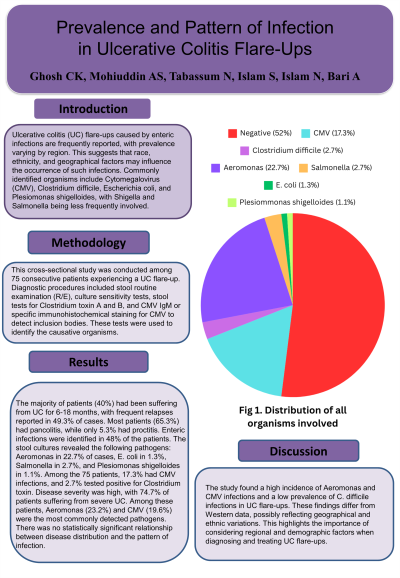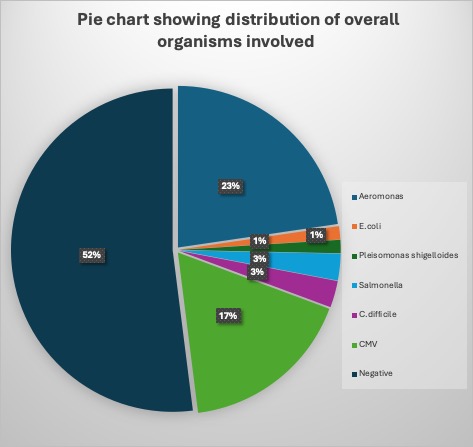Monday Poster Session
Category: IBD
P2655 - Prevalence and Pattern of Infection in Ulcerative Colitis Flare-Ups
Monday, October 28, 2024
10:30 AM - 4:00 PM ET
Location: Exhibit Hall E

Has Audio

Chanchal Kumar Ghosh, MBBS, MD
Bangabandhu Sheikh Mujib Medical University
Dhaka, Dhaka, Bangladesh
Presenting Author(s)
Chanchal Kumar Ghosh, MBBS, MD1, Syed Arafat Mohiuddin, MBBS1, Nowrin Tabassum, MBBS, MD1, Sumona Islam, MBBS, MPH, MD2, Nafizul Islam, MBBS1, Amit Bari, MBBS, MPH, MD3
1Bangabandhu Sheikh Mujib Medical University, Dhaka, Dhaka, Bangladesh; 2Bangladesh Medical College and Hospital, Dhaka, Dhaka, Bangladesh; 3Kidney Foundation Hospital and Research Institute, Dhaka, Dhaka, Bangladesh
Introduction: Ulcerative colitis (UC) flare-ups caused by enteric infections are frequently reported, with prevalence varying by region. This suggests that race, ethnicity, and geographical factors may influence the occurrence of such infections. Commonly identified organisms include Cytomegalovirus (CMV), Clostridium difficile, Escherichia coli, and Plesiomonas shigelloides, with Shigella and Salmonella being less frequently involved. This study aims to prospectively investigate the prevalence of common enteropathogenic organisms in UC flare-ups and their relation to disease activity.
Methods: This cross-sectional study was conducted among 75 consecutive patients experiencing a UC flare-up. Diagnostic procedures included stool routine examination (R/E), culture sensitivity tests, stool tests for Clostridium toxin A and B, and CMV IgM or specific immunohistochemical staining for CMV to detect inclusion bodies. These tests were used to identify the causative organisms.
Results: The majority of patients (40%) had been suffering from UC for 6-18 months, with frequent relapses reported in 49.3% of cases. Most patients (65.3%) had pancolitis, while only 5.3% had proctitis. Enteric infections were identified in 48% of the patients. The stool cultures revealed the following pathogens: Aeromonas in 22.7% of cases, E. coli in 1.3%, Salmonella in 2.7%, and Plesiomonas shigelloides in 1.1%. Among the 75 patients, 17.3% had CMV infections, and 2.7% tested positive for Clostridium toxin.
Disease severity was high, with 74.7% of patients suffering from severe UC. Among these patients, Aeromonas (23.2%) and CMV (19.6%) were the most commonly detected pathogens. There was no statistically significant relationship between disease distribution and the pattern of infection.
Discussion:
The study found a high incidence of Aeromonas and CMV infections and a low prevalence of C. difficile infections in UC flare-ups. These findings differ from Western data, possibly reflecting geographical and ethnic variations. This highlights the importance of considering regional and demographic factors when diagnosing and treating UC flare-ups.

Note: The table for this abstract can be viewed in the ePoster Gallery section of the ACG 2024 ePoster Site or in The American Journal of Gastroenterology's abstract supplement issue, both of which will be available starting October 27, 2024.
Disclosures:
Chanchal Kumar Ghosh, MBBS, MD1, Syed Arafat Mohiuddin, MBBS1, Nowrin Tabassum, MBBS, MD1, Sumona Islam, MBBS, MPH, MD2, Nafizul Islam, MBBS1, Amit Bari, MBBS, MPH, MD3. P2655 - Prevalence and Pattern of Infection in Ulcerative Colitis Flare-Ups, ACG 2024 Annual Scientific Meeting Abstracts. Philadelphia, PA: American College of Gastroenterology.
1Bangabandhu Sheikh Mujib Medical University, Dhaka, Dhaka, Bangladesh; 2Bangladesh Medical College and Hospital, Dhaka, Dhaka, Bangladesh; 3Kidney Foundation Hospital and Research Institute, Dhaka, Dhaka, Bangladesh
Introduction: Ulcerative colitis (UC) flare-ups caused by enteric infections are frequently reported, with prevalence varying by region. This suggests that race, ethnicity, and geographical factors may influence the occurrence of such infections. Commonly identified organisms include Cytomegalovirus (CMV), Clostridium difficile, Escherichia coli, and Plesiomonas shigelloides, with Shigella and Salmonella being less frequently involved. This study aims to prospectively investigate the prevalence of common enteropathogenic organisms in UC flare-ups and their relation to disease activity.
Methods: This cross-sectional study was conducted among 75 consecutive patients experiencing a UC flare-up. Diagnostic procedures included stool routine examination (R/E), culture sensitivity tests, stool tests for Clostridium toxin A and B, and CMV IgM or specific immunohistochemical staining for CMV to detect inclusion bodies. These tests were used to identify the causative organisms.
Results: The majority of patients (40%) had been suffering from UC for 6-18 months, with frequent relapses reported in 49.3% of cases. Most patients (65.3%) had pancolitis, while only 5.3% had proctitis. Enteric infections were identified in 48% of the patients. The stool cultures revealed the following pathogens: Aeromonas in 22.7% of cases, E. coli in 1.3%, Salmonella in 2.7%, and Plesiomonas shigelloides in 1.1%. Among the 75 patients, 17.3% had CMV infections, and 2.7% tested positive for Clostridium toxin.
Disease severity was high, with 74.7% of patients suffering from severe UC. Among these patients, Aeromonas (23.2%) and CMV (19.6%) were the most commonly detected pathogens. There was no statistically significant relationship between disease distribution and the pattern of infection.
Discussion:
The study found a high incidence of Aeromonas and CMV infections and a low prevalence of C. difficile infections in UC flare-ups. These findings differ from Western data, possibly reflecting geographical and ethnic variations. This highlights the importance of considering regional and demographic factors when diagnosing and treating UC flare-ups.

Figure: Pie chart showing distribution of overall organisms involved
Note: The table for this abstract can be viewed in the ePoster Gallery section of the ACG 2024 ePoster Site or in The American Journal of Gastroenterology's abstract supplement issue, both of which will be available starting October 27, 2024.
Disclosures:
Chanchal Kumar Ghosh indicated no relevant financial relationships.
Syed Arafat Mohiuddin indicated no relevant financial relationships.
Nowrin Tabassum indicated no relevant financial relationships.
Sumona Islam indicated no relevant financial relationships.
Nafizul Islam indicated no relevant financial relationships.
Amit Bari indicated no relevant financial relationships.
Chanchal Kumar Ghosh, MBBS, MD1, Syed Arafat Mohiuddin, MBBS1, Nowrin Tabassum, MBBS, MD1, Sumona Islam, MBBS, MPH, MD2, Nafizul Islam, MBBS1, Amit Bari, MBBS, MPH, MD3. P2655 - Prevalence and Pattern of Infection in Ulcerative Colitis Flare-Ups, ACG 2024 Annual Scientific Meeting Abstracts. Philadelphia, PA: American College of Gastroenterology.
